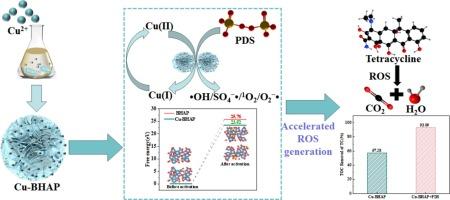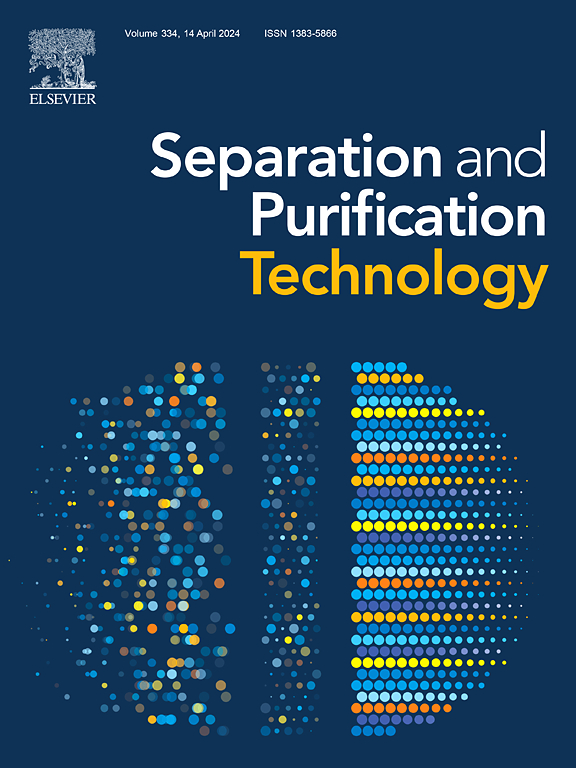Biogenic Cu-based hydroxyapatite nanocomposites for efficient clean of antibiotics: Performance and mechanism
IF 8.1
1区 工程技术
Q1 ENGINEERING, CHEMICAL
引用次数: 0
Abstract
Copper-based catalysts are capable of activating persulfate (PDS) and effectively degrading persistent antibiotic pollutants. In this study, we developed a novel biomineralization regulation strategy to synthesize copper-biomass-hydroxyapatite (Cu-BHAP) composite, aiming to create an environmentally friendly, non-toxic copper-based catalyst for antibiotic degradation as resource recycling. More specifically, biomineralization enhances the adsorption capacity of biomass-hydroxyapatite for copper by increasing its electron transfer rate, and the saturated adsorption capacity for Cu2+ reached 154.3 mg/g. The experimental results showed that the prepared Cu-BHAP sample exhibited superior catalytic activity in the PDS activation process, and 96.19 % removal efficiency of 40 mg/L tetracycline (TC) was achieved within 10 min without pH adjustment (initial pH = 5.8). Meanwhile, density functional theory (DFT) calculation confirmed that the Cu-BHAP catalyst enhanced the electron supply capacity and promoted the activation of PDS. According to scavenger and chemical probe experiments, abundant reactive oxygen species including sulfate radical (SO4−•), hydroxyl radical (•OH), superoxide radical (O2−•), and singlet oxygen (1O2) were responsible for the effective degradation of TC. The potential degradation intermediates of TC were investigated by LC-MS and proved to be less toxic than TC through the ecological structure–activity relationship procedure. Cu-BHAP exhibits a low ion leaching rate, robust performance, and excellent stability. This study provides a simple and green environmental remediation strategy for preparing effective copper-based PDS activators.


生物源铜基羟基磷灰石纳米复合材料用于抗生素的高效清洁:性能和机制
铜基催化剂能够活化过硫酸盐(PDS),有效降解持久性抗生素污染物。在本研究中,我们开发了一种新的生物矿化调节策略来合成铜-生物质-羟基磷灰石(Cu-BHAP)复合材料,旨在为抗生素降解创造一种环境友好,无毒的铜基催化剂,作为资源循环利用。生物矿化作用通过提高羟基磷灰石对铜的电子传递速率,增强了羟基磷灰石对铜的吸附能力,对Cu2+的饱和吸附量达到154.3 mg/g。实验结果表明,制备的Cu-BHAP样品在PDS活化过程中表现出优异的催化活性,在不调整pH(初始pH = 5.8)的情况下,在10 min内对40 mg/L四环素(TC)的去除率达到96.19%。同时,密度泛函理论(DFT)计算证实Cu-BHAP催化剂增强了电子供应能力,促进了PDS的活化。通过清除剂和化学探针实验发现,丰富的硫酸盐自由基(SO4−•)、羟基自由基(•OH)、超氧自由基(O2−•)和单线态氧(1O2)等活性氧是有效降解TC的主要原因。LC-MS研究了TC的潜在降解中间体,并通过生态构效关系程序证明其毒性低于TC。Cu-BHAP具有离子浸出率低、性能稳定、稳定性好等特点。本研究为制备有效的铜基PDS活化剂提供了一种简单、绿色的环境修复策略。
本文章由计算机程序翻译,如有差异,请以英文原文为准。
求助全文
约1分钟内获得全文
求助全文
来源期刊

Separation and Purification Technology
工程技术-工程:化工
CiteScore
14.00
自引率
12.80%
发文量
2347
审稿时长
43 days
期刊介绍:
Separation and Purification Technology is a premier journal committed to sharing innovative methods for separation and purification in chemical and environmental engineering, encompassing both homogeneous solutions and heterogeneous mixtures. Our scope includes the separation and/or purification of liquids, vapors, and gases, as well as carbon capture and separation techniques. However, it's important to note that methods solely intended for analytical purposes are not within the scope of the journal. Additionally, disciplines such as soil science, polymer science, and metallurgy fall outside the purview of Separation and Purification Technology. Join us in advancing the field of separation and purification methods for sustainable solutions in chemical and environmental engineering.
文献相关原料
公司名称
产品信息
麦克林
Sodium persulfate
 求助内容:
求助内容: 应助结果提醒方式:
应助结果提醒方式:


